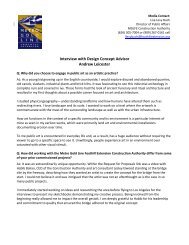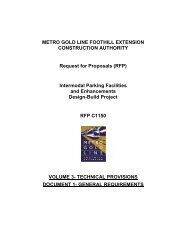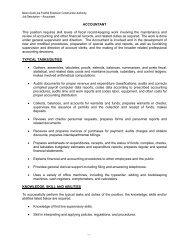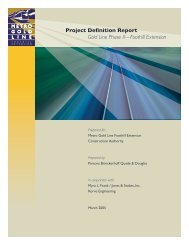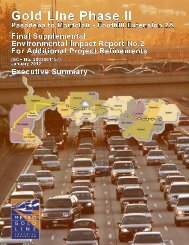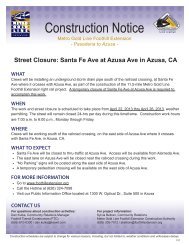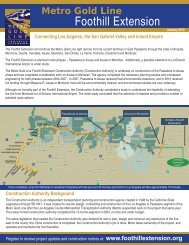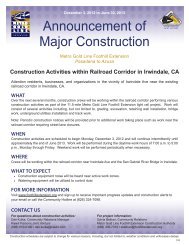Part 3 - Metro Gold Line Foothill Extension
Part 3 - Metro Gold Line Foothill Extension
Part 3 - Metro Gold Line Foothill Extension
Create successful ePaper yourself
Turn your PDF publications into a flip-book with our unique Google optimized e-Paper software.
Noise and Vibration Technical Report: <strong>Metro</strong> <strong>Gold</strong> <strong>Line</strong> <strong>Foothill</strong> <strong>Extension</strong>, Azusa to Montclair<br />
July 2012<br />
Page 91<br />
The two primary factors that reduce levels of environmental sounds are increasing the distance between<br />
the sound source and the receiver and having intervening obstacles such as walls, buildings, or terrain<br />
features that block the direct path between the sound source and the receiver. Factors that act to make<br />
environmental sounds louder include moving the sound source closer to the receiver, sound enhancements<br />
caused by reflections, and focusing caused by various meteorological conditions.<br />
Following are brief definitions of the measures of environmental noise used in this study:<br />
• Maximum Sound Level (Lmax): Lmax is the maximum sound level that occurs during an event such<br />
as a train passing. For this analysis Lmax is defined as the maximum sound level using the slow<br />
setting on a standard sound level meter.<br />
• Equivalent Sound Level (Leq): Environmental sound fluctuates constantly. The equivalent sound<br />
level (Leq) is the most common means of characterizing community noise. Leq represents a<br />
constant sound that, over a specified period of time, has the same sound energy as the timevarying<br />
sound. Leq is used by the FTA to evaluate noise effects at institutional land uses, such as<br />
schools, churches, and libraries, from proposed transit projects.<br />
• Day-Night Sound Level (Ldn): Ldn is basically a 24-hour Leq with an adjustment to reflect the<br />
greater sensitivity of most people to nighttime noise. The adjustment is a 10 dB penalty for all<br />
sound that occurs between the hours of 10:00 p.m. to 7:00 a.m. The effect of the penalty is that,<br />
when calculating Ldn, any event that occurs during the nighttime is equivalent to ten occurrences<br />
of the same event during the daytime. Ldn is the most common measure of total community noise<br />
over a 24-hour period and is used by the FTA to evaluate residential noise effects from proposed<br />
transit projects.<br />
• LXX: This is the percent of time a sound level is exceeded during the measurement period. For<br />
example, the L99 is the sound level exceeded during 99 percent of the measurement period. For a<br />
1-hour period, L99 is the sound level exceeded for all except 36 seconds of the hour. The tables of<br />
the hourly noise levels in Appendix B include L1, L33, L50, and L99, the sound levels exceeded<br />
1 percent, 33 percent, 50 percent and 99 percent of the hour. L1 represents typical maximum<br />
sound levels, L33 is approximately equal to Leq when free-flowing traffic is the dominant noise<br />
source, L50 is the median sound level, and L99 is close to the minimum sound level.<br />
• Sound Exposure Level (SEL): SEL is a measure of the acoustic energy of an event such as a train<br />
passing. In essence, the acoustic energy of the event is compressed into a 1-second period. SEL<br />
increases as the sound level of the event increases and as the duration of the event increases. It is<br />
often used as an intermediate value in calculating overall metrics such as Leq and Ldn.<br />
• Sound Transmission Class (STC): STC ratings are used to compare the sound insulating<br />
effectiveness of different types of noise barriers, including windows, walls, etc. Although the<br />
amount of attenuation varies with frequency, the STC rating provides a rough estimate of the<br />
transmission loss from a particular window or wall.<br />
Vibration Fundamentals<br />
One potential community effect from the proposed project is vibration that is transmitted from the tracks<br />
through the ground to adjacent houses. This is referred to as groundborne vibration. When evaluating<br />
human response, groundborne vibration is usually expressed in terms of decibels using the root mean



